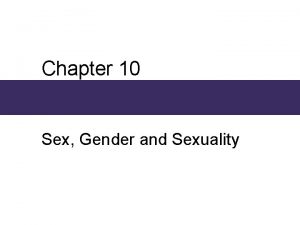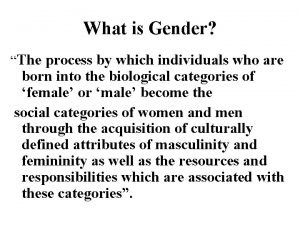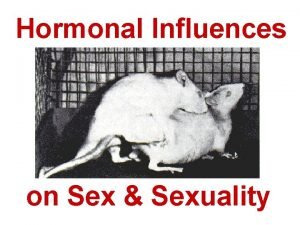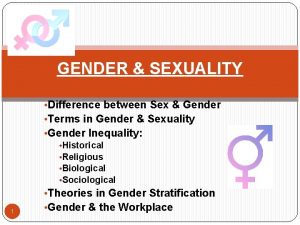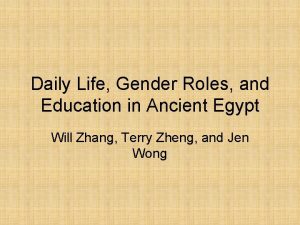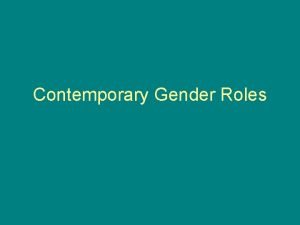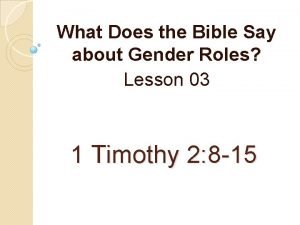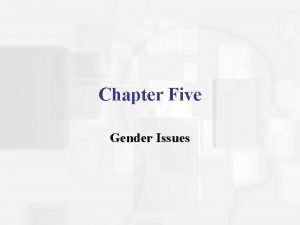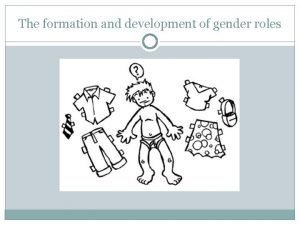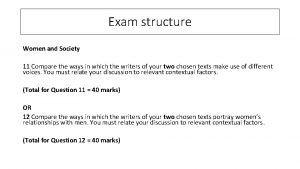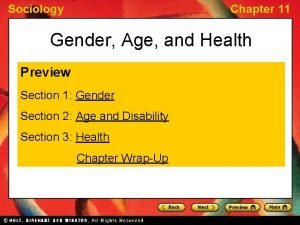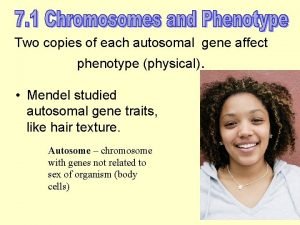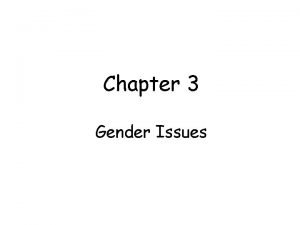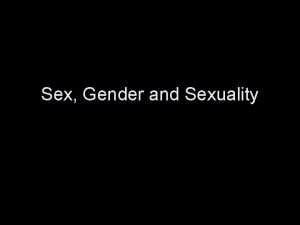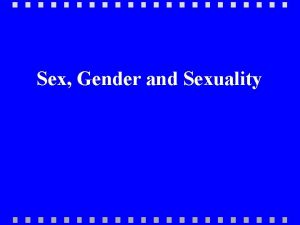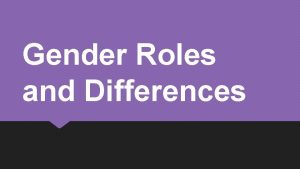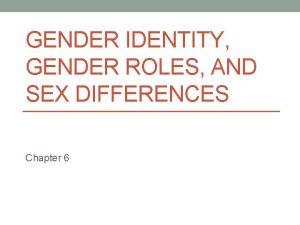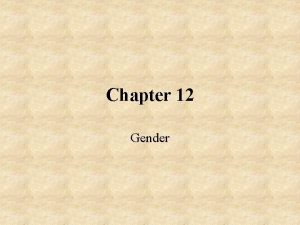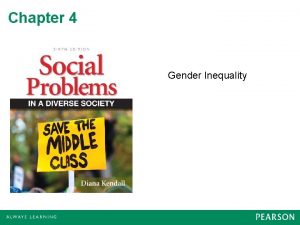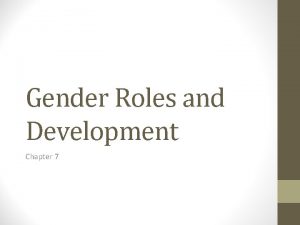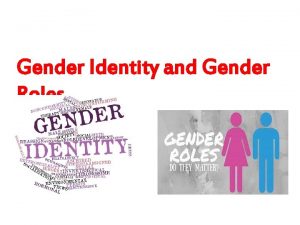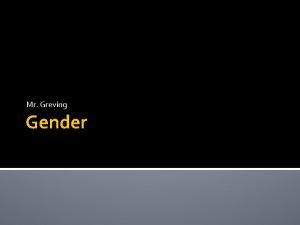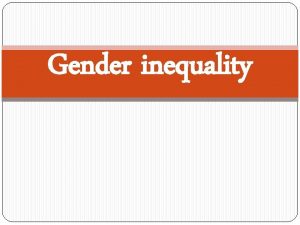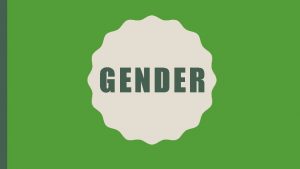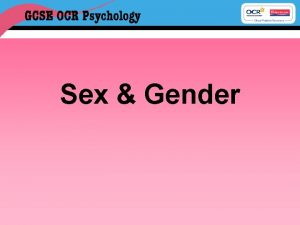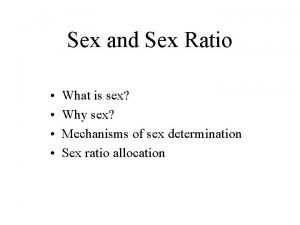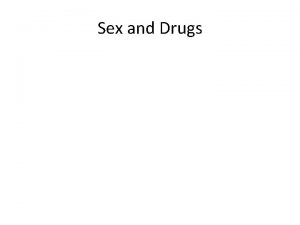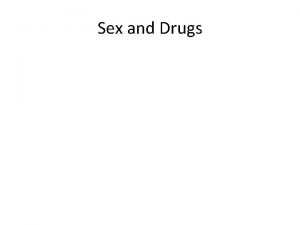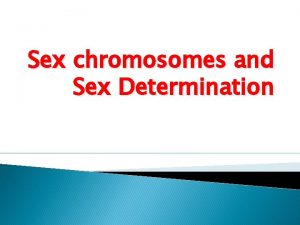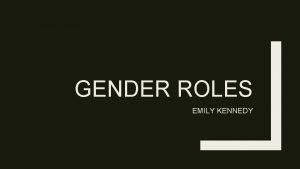Chapter 5 Gender and Gender Roles Sex Gender




































- Slides: 36

Chapter 5 Gender and Gender Roles

Sex, Gender, and Gender Roles • Sex: whether one is biologically female, or intersex – Genetic sex: chromosomal and hormonal sex characteristics – Anatomical sex: our physical sex; gonads, uterus, vulva, vagina, or penis • Gender: social and cultural characteristics associated with being male or female • Gender identity: gender one believes self to be

Sex and Gender Identity • • Assigned gender Gender variations Gender identity Gender role

Gender-Roles • Gender-role stereotype • Gender-role attitude – The belief concerning what’s appropriate for male or female traits • Gender-role behavior – Activities or behaviors a person engages in as a female or male

Masculinity and Femininity • Sexes seen as polar opposites in traditional Western view, e. g. “opposite sex” • Different qualities associated with different genders • Sexism • Some qualities are biologically based, some culturally based

Gender and Sexual Orientation • Gender, gender identity, and gender role are conceptually independent of sexual orientation • Heterosexuality has been assumed to be part of masculinity and femininity

Gender Theory • Developed in the ’ 80 s and ’ 90 s to explore the role of gender in society • Seeks to understand society through understanding how its organized by gender • Views gender as a basic element in social relationships

Gender Theory in Psychology • How gender is created and its purposes • How specific traits, behaviors, and roles are defined as male or female • How gender creates advantages and disadvantages • Rejects the idea that gender differences are primarily biologically-driven • Operates from a social-constructivist framework

Theories of Socialization • Social learning theory • Cognitive development theory

Cognitive Social Learning Theory • Emphasizes consequences as shaping gender related behavior • Cognition: Mental processes such as evaluation and reflection – Includes ability to use language – Anticipate consequences – Modeling

Cognitive Development Theory • Focuses on children’s active interpretation of gender • After age 6 or 7, motivation to act like one’s gender is primarily internal, and that gender -role behavior is intrinsic

Social Construction Theory • Gender expression is an outcome of – Power – Language – Meaning • Relationship to sexual orientation – Women – Men

Gender-Role Learning: Childhood and Adolescence • Parents as socializing agents – Manipulation – Channeling – Verbal appellation – Activity exposure – Connections between sons and mothers – Ethnic groups

Gender-Role Learning: Childhood and Adolescence • Teachers as Socializing agents – Females are more common – Bias in presentation of topics • Peers as socializing agents – Play – Approval – Perceptions • Media

Gender Schemas: Exaggerating Differences • Interrelated ideas help information processing • Cognitive organization of world by gender • Emphasize dichotomy • Minimize valuing of the individual

Contemporary Gender Roles • • Women’s roles have changed Must include diverse groups Egalitarian approach to gender roles

Traditional Male Gender Role • Aggressiveness • Emotional toughness • Independence • Feelings of superiority • Decisiveness • • Power orientation Competitiveness Dominance Violence

Traditional Male Sexual Scripts: Zilbergeld – Men should not have or express certain feelings – Performance is the only thing that counts – The man is in charge – A man always wants sex and is ready for it – All physical contact leads to sex – Sex equals intercourse – Sexual intercourse leads to orgasm

Traditional Female Gender Role • American middle-class Whites: women as wives and mothers. Recently includes work outside the home • African Americans: more egalitarian roles for men and women • Latinas: women subordinate to men out of respect; Gender role affected by age

Traditional Female Sexual Scripts: • Sex is good and bad • It’s not okay to touch yourself “down there” • Sex is for men • Men should know what women want • Women shouldn’t talk about sex • Women should look like models • Women are nurturers: they give, men receive • There is only one right way to have an orgasm

Changing Gender Roles • Egalitarian position • Androgyny: flexibility in gender roles, combining elements of each traditional role

Contemporary Sexual Scripts • Sexual expression is positive • Sexual activities involve a mutual exchange of erotic pleasure, and both partners are equally responsible • Legitimate sexual activities are not limited to intercourse but include masturbation and oral sex • Sexual activities may be initiated by either partner • Both partners have a right to experience orgasm, whether through intercourse, oral sex, or manual stimulation • Non-marital sex is acceptable within a relationship context

Androgyny • Unique combination or instrumental and expressive traits • Difficulties with expression and expectation

When Sex is Ambiguous • Intersexuality • Transgenderism

Intersexuality • Possess mixtures of male and female genitalia or reproductive physiology • Known until recently as “hermaphrodites” • Shrouded in secrecy by families and medical establishments in the past

Intersexuality • • Hermaphrodites: Old terminology Ambiguous genitals: 1/2000 births Blended gonads or both gonads One ovary and one testis, or testes containing ovarian tissue

Chromosomal Anomalies: Turner Syndrome • Females who lack a chromosome: XO rather than XX • Occurs in 1/1666 live births • Female external appearance • No ovaries • Hormonal therapy • Assisted fertility

Chromosomal Anomalies: Klinefelter Syndrome • Males who have extra X chromosomes: XXY, XXXY, or XXXXY rather than XY • Occurs in 1/1000 live births • Variable effects; many men never diagnosed. • Small firm testes; some female physical traits • Lower testosterone levels

Hormonal Disorders: Androgen. Insensitivity Syndrome • Inherited condition occurring in 1/13, 000 individuals • Genetic males whose tissues do not respond to testosterone • Female genitals, no female internal organs • At puberty, develops hips and breasts, no pubic hair and no menstruation • Many experience female gender identity

Hormonal Disorders: Congenital Adrenal Hyperplasia • A genetic female with ovaries and a vagina develops externally as a male • Due to malfunctioning of adrenal gland • Occurs in 1/13, 000 live births – At birth, ambiguous genitalia – In the past, doctors and families choose to assign female gender at birth

Hormonal Disorders: DHT deficiency • • Internal male organs Clitoris-like penis at birth Undescended testes at birth Testes descend at puberty and penis grows • Socialization

Hypospadias • Urethral opening is not in correct location • Exists on underside of glans • Occurs in 1/770 male births • Repair is possible

Gender Identity Disorder • A strong and persistent cross-gender identification and persistent discomfort about one’s assigned sex • Diagnosis not associated as hormonal or physiological • Requires experience of distress or impairment in social, occupational, or other areas of functioning

Gender Identity Disorder • Lasting personal comfort with the gendered self • Treatment is individual and multifaceted – Psychotherapy – Real-life experience living externally as desired gender – Hormonal therapy – Sex-reassignment surgery

Transsexuality • Gender identity and sexual anatomy are not congruent • Estimated 1/50, 000 people over 15 yrs • May occur with heterosexual, homosexual, and bisexual orientations • Gender reassignment

Transsexual Phenomenon • Embraces possibility of numerous genders and multiple social identities • Other cultures recognize more than 2 genders • Paradigm shift of gender dichotomy • Employment protection
 Kurt bumby
Kurt bumby Sex in the greenhouse
Sex in the greenhouse Xxtesticles
Xxtesticles Sex sex sex
Sex sex sex Secondary sexual characters
Secondary sexual characters Chapter 10 sex gender and sexuality
Chapter 10 sex gender and sexuality Punnett square for sex linked traits
Punnett square for sex linked traits Sex determination and sex linkage
Sex determination and sex linkage Sex determination and sex linkage
Sex determination and sex linkage Once a sex offender always a sex offender
Once a sex offender always a sex offender Difference between gender and sex
Difference between gender and sex Difference between gender and sex
Difference between gender and sex Sex
Sex Difference between gender and sex
Difference between gender and sex Difference between sex and gender
Difference between sex and gender Gender roles in snow white
Gender roles in snow white Gender roles theory
Gender roles theory Gender issue in school
Gender issue in school Sex vs gender essay video
Sex vs gender essay video Strategic gender needs and practical gender needs
Strategic gender needs and practical gender needs Is there any bias in gender roles based on the excerpt
Is there any bias in gender roles based on the excerpt Ancient gender roles
Ancient gender roles Contemporary gender roles
Contemporary gender roles Gender inequality quiz
Gender inequality quiz Gender representation in casablanca
Gender representation in casablanca What does the bible say about gender roles
What does the bible say about gender roles Gender roles theory
Gender roles theory Indus valley gender roles
Indus valley gender roles Qin dynasty gender roles
Qin dynasty gender roles Tchambuli gender roles
Tchambuli gender roles Motifs in a thousand splendid suns
Motifs in a thousand splendid suns Chapter 11 gender age and health review worksheet answers
Chapter 11 gender age and health review worksheet answers Importance of service delivery
Importance of service delivery Customer roles in service delivery
Customer roles in service delivery Mentor and mentee roles and responsibilities
Mentor and mentee roles and responsibilities Difference between autosomes and sex chromosome
Difference between autosomes and sex chromosome Sex male and female
Sex male and female





